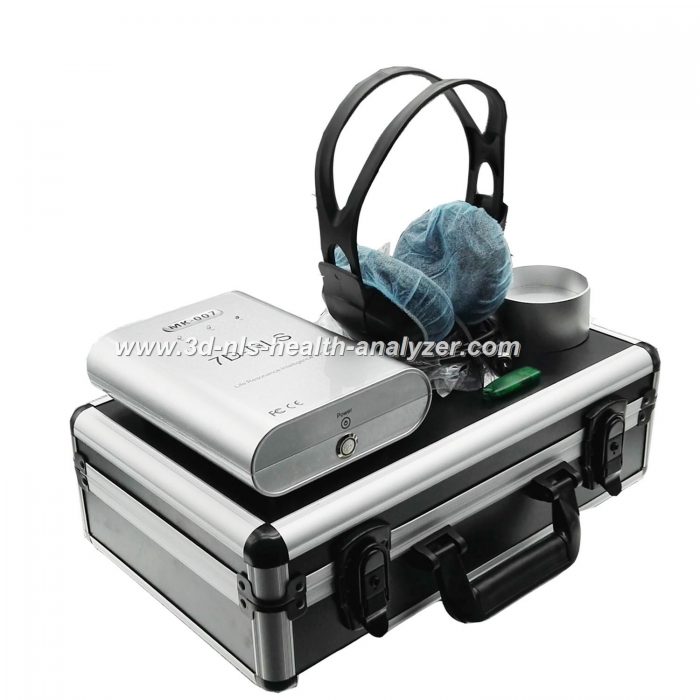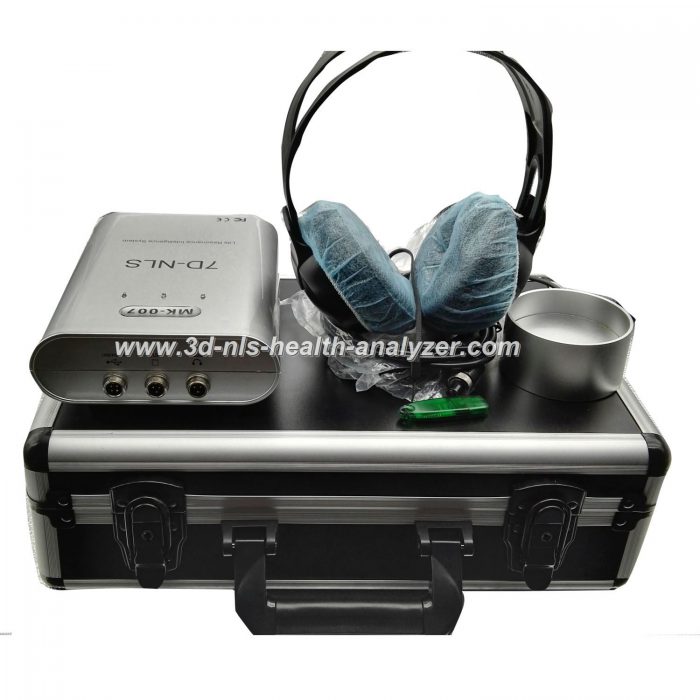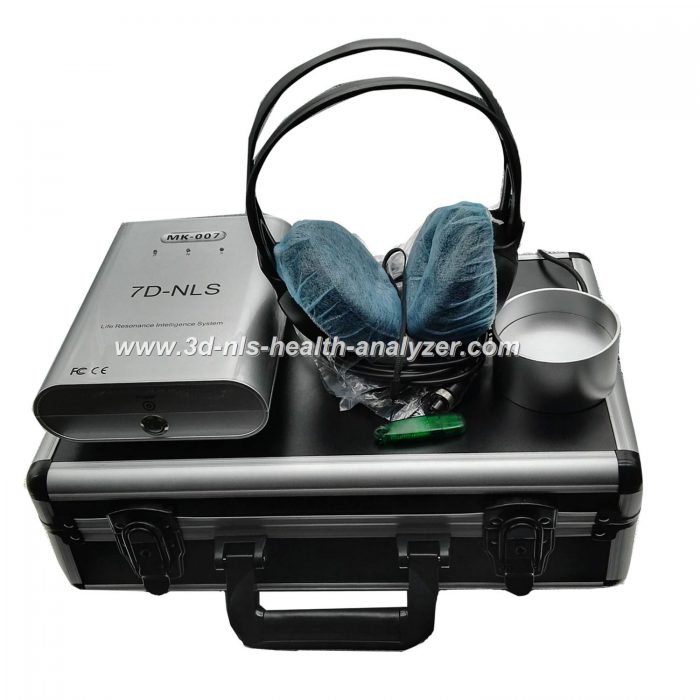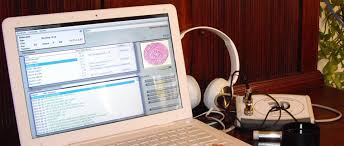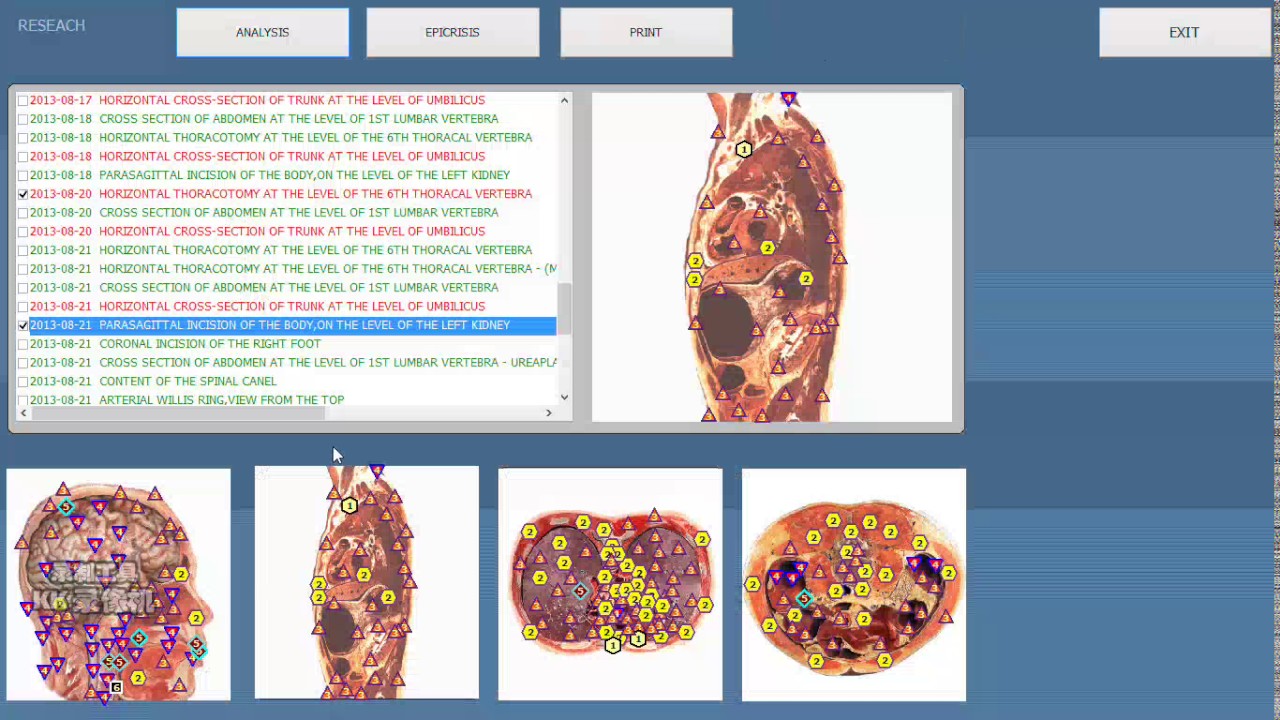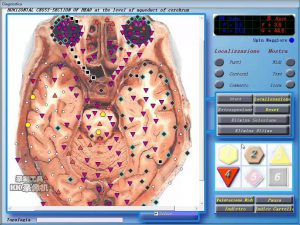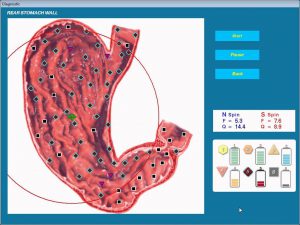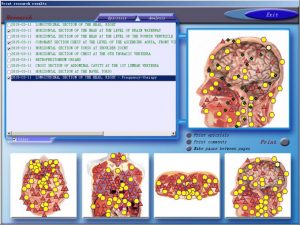NLS Physics of Information Medicine.pdf free download parts 6



ducted with respect to the ability of the patient to change the brainwave fre?
quency. A method and device for interpreting concepts and conceptual
thoughts from a brainwave date of a patient and for assisting in diagnosis of a
brainwave dysfunction is described is proposed by Hudspeth in the U.S. Pat.
No. 5,392,788. A system is described to include a transducer for transmitting
a stimuli to the patient, EEG transducers for recording brainwave signals,
and a computer to control signal presentation, EEG signal recording and
analysis. A comparison is made between the recorded EEG signals and a
model of conceptual perceptional and emotional thought or as an alternative
to the known EEG signals from healthy individuals to diagnose a brain dys?
function.
A method for determining the intensity of focused attention is proposed
by Cowan et al. in the U.S. Pat. No. 5,983,129 and includes obtaining a
frontal lobe brainwave EEG signal and subtracting it from a separately
obtained reference EEG signal to produce the attention indicator signal.
Finally, an electroencephalograph based biofeedback system is described
by Freer in the U.S. Pat. No. 6,097,981 in which a computer animation is
maintained by the computer and presented to the patient while EEG
response signals are simultaneously being obtained and analyzed. Results of
the analysis are then used to control the animation. A provision is made to
send the EEG signals from the head of the patient or user to the machine by
remote infrared transmitter.
All the above systems suffer from a number of common limitations, which
stem from their dependence on the conscious state of mind of the patient.
Another limitation is that the patient himself is used to interpret the biofeed?
back signal rather then an independent entity such as an operator. Finally,
hardware is used to obtain the EEG signals and transmit it via a wire or
infrared method to the main data collection and computing apparatus.
One further improvement in the accuracy of biofeedback analysis is
described in the Russian Patent No. 759,092 in which various biofeedback
signals are assigned a certain value of relative weight by a dedicated designa?
tion unit acting based on individual characteristics of each patient or a test
subject. Varying these weight factors allows the apparatus to customize the
results of analysis for each individual user.
The use of magnetic and electromagnetic fields is also known in the art to
remotely and non?invasively assess certain conditions of a patient or to influ?
ence his state of fatigue and abilities to perform certain functions.
Farmer et al. has described a device for monitoring a magnetic field ema?
nating from an organism in the U.S. Pat. No. 5,458.142. It includes a mag?
netic field sensor containing a ferromagnetic core surrounded by a multi?turn
67
The situation of playing a dynamic game is used in various psycho?physi?
ological evaluation devices to determine the state of a variety of body func?
tions. Examples include such functions as attention, memory and vision
(Russian Patent No. 825,001); sensing and motor reactions (Russian Patent
No. 850,043); ability to choose (Russian Patent No. 929,060); the function
of following a moving object (Russian Patent No. 827,029); ability to find the
ways out of the difficult situation (Russian Patent No. 878,258) and even the
predictive abilities (Russian Patent No. 839, 488).
A more comprehensive biofeedback device is described by Schweizer in
the U.S. Pat. No. 4,195,626 and includes application of a variety of audible,
visual, electrical or tactile stimuli in a specially designed biofeedback cham?
ber. Moreover, a microprocessor controlled rhythmical pattern of these stim?
uli is proposed and is adjusted based on the patient’s own reactions.
Ross et al. in the U.S. Pat. No. 4,690,142 suggests electro?neurological
stimulation of specifically described places on the skin of the patient.
Production of such tactile stimulation of the skin is used to generate electri?
cal characteristics of the organism responsive to a particular condition. The
system of the invention is also used to train the organism to change its reac?
tion to the stimuli by concentrating on increasing or inhibiting the tactile
sensation.
An even more sophisticated system involves detecting the patient’s elec?
trical brainwaves via electroencephalogram or EEG as measured from a
number of electrodes attached to the patient’s scalp. Several examples of
EEG based biofeedback devices are worth mentioning here among a large
number of such systems described in the prior art.
A multiple channel biofeedback .computer is described in the U.S. Pal.
No. 4,031,883 by Fehmi et al. which contains a number of monopolar elec?
trical contacts applied to the scalp and the body of the patient and a comput?
er for collecting, filtering and amplifying the electrical signals therefrom. The
overall feedback signal is then presented back to the patient to create aware?
ness of the function being monitored of for other purposes.
Ross et al. in the U.S. Pat. No. 4,800,893 describes a kinesthetic physical
movement display in which a number of electrodes feed their respective sig?
nals to an EEG apparatus equipped with a video display. Generation of kines?
thetic physical movements allows the user to produce desired thought pat?
terns.
A method for treating a patient using an EEG feedback is described by
Ochs in the U.S. Pat. No. 5,365,939 and involves selecting a reference site for
determining a brainwave frequency and entraining it in both directions until
a predetermined stop point is reached. Flexibility assessment is then con?
66
uli to both the operator and the patient. Such stimuli can be chosen of vari?
ous types depending on the purpose of evaluation. They can be of optical
(such as a screen of a monitor, a series of light diodes, etc.), sound (via head?
sets or speakers), or magnetic nature. A triggering sensor facilitates the
biofeedback formation and transmittal from the patient to the CPT device via
an analog?to?digital converter. Another biofeedback loop is formed in paral?
lel between the operator and the patient. It is therefore the operator who is
actively participating in the evaluation and interprets its results. To further
increase the ability of the patient to intuitively cause the triggering sensor to
send the feedback signal, a device called “cadistor” provides an intuition
enhancement. This devise subjects the patient to a series of small level ener?
gy bursts with the 5 frequency preferably coinciding with the theta rhythm of
the patient’s brainwaves.
BRIEF DESCRIPTION OF THE DRAWINGS
A more complete appreciation of the subject matter of the present inven?
tion and the various advantages thereof can be realized by reference to the
following detailed description in which reference is made to the accompany?
ing drawings in which:
FIG. 1 is a general block?diagram of the diagnostic system of the present
invention, and
FIG. 2 is a general block?diagram of the triggering sensor of the diagnos?
tic system.
DETAILED DESCRIPTION OF THE
PREFERRED EMBODIMENT OF THE INVENTION
A detailed description of the present invention follows with reference to
accompanying drawings in which like elements are indicated by like ference
letters and numerals. FIG. 1 shows the main block?diagram of the proposed
system of the present invention.
A CPT device 10 contains a situation?generating block designed to out?
put a predetermined series of stimuli, also called “information codes” and
transmits it through a dual peripheral device to both the operator 20 and the
patient 30 (shown as dotted lines on FIG. 1). A number of appropriate
peripheral devices can be employed with the system depending on the nature
of the information code. Examples of such peripheral device include but not
limited to: a magnetic induction coil for modulated magnetic field transmis?
sion, headsets or speakers for audio transmission, video monitor or a light
69
fine wire. The sensor is used to record the magnetic fields of an organism for
diagnostic purposes as well as to control a magnetic field generator in order
to produce a therapeutic magnetic field complimentary to that of an organ?
ism.
A bio?magnetic analytical system is described by Zanakis et al. in the U.S.
Pat. No. 4,951,674 and includes a number of fiber?optic magnetic sensors to
obtain information about the magnetic field from various tissues in the body
including the brain.
A device for influencing an organism is proposed by Hein in the U.S. Pat.
No. 5,108,361 and involves exposing the patient to a number of short pulsed
signals supplied with increasing or decreasing frequency to stimulate the
cerebral waves.
U.S. Pat. No. 5,769,878 by Kamei suggests a device for non?invasive
enhancing the immuno?surveillance capacity of a person by supplying a
pulsed light to his forehead (while shielding the eyes) in the frequency range
between 0.5 to 13 Hz and preferably in the frequency of the alpha wave band
as measured from the EEG signals.
Finally, our Russian Patent No. 2,342,826 describes a method and device
for increasing non?invasively the accuracy and output of an operator of a bio?
location device by using a low frequency unipolar magnetic field.
The need therefore exists for a non?invasive diagnostic system excluding
the conscious influence of the patient and his own interpretation of the
biofeedback signal.
SUMMARY OF THE INVENTION
Accordingly, it is an object of the present invention to overcome these and
other drawbacks of the prior art by providing a novel non?invasive diagnostic
system using a central processing and telemetry device and an operator to
interpret the biofeedback signal from the patient.
It is another object of the present invention to provide a diagnostic system
capable of processing the biofeedback from both the patient and the opera?
tor. It is a further object of the present invention to provide a diagnostic sys?
tem in which the biofeedback from the patient is collected non?invasively.
It is yet a further object of the present invention to provide a diagnostic
system in which a device is provided to enhance the intuition of the patient
to facilitate the formation of the biofeedback signal from to the patient to the
apparatus.
The diagnostic system of the invention includes a central processing and
telemetry (CPT) device capable of providing a predetermined series of stim?
68
mended to avoid damage by the laser. The laser source is located only about
5?6 inches from the patient’s forehead and is directed onto the cadistor
placed on the patient’s head as described above. Activation of periodic illu?
mination of the cadistor with the laser light causes periodic release of the
energy, which in this situation was clearly shown to increase the intuitive
potential of the patient. It is also important to orient the cadistor properly in
a space relative to one of the elements of the triggering sensor 40, namely its
antenna.
In the above?described situation, both the electromagnetic and the tor?
sion components of the laser Sight are directed at the patient. To block the
electromagnetic component, a cavity resonator is deployed which prevents
the electromagnetic component from getting through while forming and
directing the torsion component as the only stimulus to effect the patient
(dashed line on FIG. 1). The cavity resonator is typically made of metal and
has a volumetric chamber with the size selected to be a multiple of the wave?
length of the incoming signal, preferably about 1.45 GHz.
FIG. 2 depicts the general block?diagram of the triggering sensor 40. It
consists of a sensing element 41, integrator 42, source of electrical current 43,
71 70
Fig.2
display for visual signal transmission such as an image of the evaluated organ
for example, etc. It is essential to point out that such information codes are
transmitted to both the operator 20 and the patient 30, a unique feature of the
diagnostic system of the invention.
A triggering sensor 40 collects the biological response from the patient
30 as an analog signal (solid line on FIG. 1), converts it into a digital one and
sends it back to the CPT unit (dash?and?dot line on FIG. 1) as will be
described in more detail below. The CPT unit is also equipped with the des?
ignation block for assigning specific relative weights in the input signals from
the sensor 40 depending on individual characteristics of the patient.
Cadistor 50 is designed to work directly with the patient 30 to facilitate the
work of the triggering sensor 40. It consists of a silicon?based semi?conduc?
tive transistor crystal acting as optoelectronic radioelement when illuminat?
ed by a light source such as a laser. Preferably, a silicon field?effect transistor
is used in which a control area is in the form of a thin flat channel. When a
laser light is directed at cadistor, an abrupt temporary short circuit is formed
in the semiconductor and a small level of energy is released. Repeating of that
process with high frequency caused periodic releases and accumulation of the
energy. It has been established that the preferred wavelength of laser light is
between 630 and 680 nanometers, the laser power should be below 5 MW
and most importantly the light pulsation has to coincide with the theta?
rhythm of the patient’s brainwaves. The cadistor is placed on the forehead of
the patient about ? of an inch above the nose and the eyes and symmetrical
there between. Appropriate eye shielding and other precautions are recom?
Fig.1
formation. The need for a galvanic decoupling unit 47 is dictated by the pres?
ence of random fluctuating electromagnetic noise fields from the power sup?
ply lines of the device itself as well as from other nearby located electrical
devices. This device is designed to separate alternating component from
direct current and contains an optical channel including a photo diode
PhD265A and an emitter AL107B made for example by Diode company in
Moscow, Russia.
The detector channel 48 is designed to increase the influence of the
patient to the sensing element 41. Reception is conducted in the short wave
range, preferably at a frequency of 1.45 GHz, which is known to be in the
range of radiowave transmission by human organs and tissues. Reception ele?
ment is made with the help of logoperiodic antenna 48a which has a multi?
turn spiral tapered design to ensure narrow direction of reception but in a
wide range of transmission frequencies. The taper is oriented with the help of
the laser pointer in such a way that its narrow portion is aimed directly at the
middle of the front forehead of the patient about ? inch above the eyes.
The mixer 48b is mounted preferably directly onto the antenna 48a and
comprises a series of diodes (such as the type AA123 made by NIIPP com?
pany in Tomsk, Russia) onto which a voltage is fed from the heterodyne 48e.
Such heterodyne is typically a sine voltage generator and is widely used in
radio receivers. It is tunable simultaneously with the tuning of the oscillatory
circuit of the receiver, to which the antenna is connected. This makes it pos?
sible to mark a stationary value of difference at a frequency between that of
the received signal and the heterodyne signal in any position of the settings of
a radio receiver. An example of an appropriate heterodyne is the one based on
the diode of the type KA717B?4 produced by Nalchk’s PP factory in
Nalchik, Russia.
The rectifier 48c is designed to separate the low frequency phase from the
useful signal, which is in turn fed into the discriminator 48d such as for exam?
ple a differential amplifier INA128UB. Discriminator 48d subtracts the inte?
grated signal from the raw signal and arrives at informational voltage bursts.
Such voltage bursts are then fed back into the integrator 42 and further into
the current source 43 which changes the value level of the current and shifts
the power current of the sensing element 41. Such fluctuations of the current
of the sensing element 41 ultimately effect the frequency spectrum of its
operation and the frequency range of the useful signal produced thereby.
The diagnostic system of the present invention functions in the fol?
lowing way. Upon initiation of the test sequence, the CPT unit 10 generates
information codes as electromagnetic, radio, audio, or light signals depend?
ing on the nature of evaluation. Such signals or stimuli influence the recep?
73
differential amplifier 44, amplifier 45, comparator 46, galvanic decoupling
unit 47, and detector channel 48 designed to increase the influence of the
patient on the sensing element 41. The detector channel 48 in turn consists
of a logoperiodic antenna 48a, mixer 48b, rectifier 48c, discriminator 48d,
and heterodyne 48e.
The function of the triggering sensor 40 is to sense the response produced
by the patient in reaction to the information codes supplied by the CPT unit,
transform them into a digital signal and send them back to the CPT unit 10.
The sensing element 41 is the noise generator based for example on the
radioelement 2G401V that is remotely subjected to the influence of the
patient’s brainwaves. A direct electrical current of an optimized value in the
range of only several microamps, preferably between 1 and 5, is provided to
power this element by power supply 49. This current is adjustable and is
determined individually during the fine?tuning of the device in?vitro.
Electrical current source 43 consists of an operation amplifier such as for
example the type UD25A (made by Voshod company in Kaluga, Russia) and
an adjusting element such as a bi?polar transistor with low noise coefficient,
for example the model KT3107L (made by Eleks company in Alexandrov,
Russia) capable of supplying a consistent level of electrical current which is
not effected by fluctuations of the power source voltage. The choice of low
levels of such current is dictated by the desire to increase the sensitivity of the
device to the outside disturbances.
The information signal is obtained from the sensing element 41 and
taken through an amplifying phase consisting of a differential amplifier 44
and an amplifier 45. As a result, the signal is amplified with a total amplifica?
tion factor of about 30 dB. The sensing element 41 is influenced by both the
useful disturbances and random disturbances such as those from static elec?
tromagnetic fields. To eliminate such random disturbances, a precision dif?
ferential amplifier 44 is used as a first phase of amplification. One possible
type of such an amplifier may be INA 128UB by BUR BRAUN in which the
signal voltage from the sensing element 41 is fed onto one input of the ampli?
fier 44 while the other input is supplied with the same voltage after feeding it
through the integrato integrator 42. As a result, only the useful disturbance
signal is allowed to go through to the next phase of amplification in the
amplifier 45 while the noise signal is filtered out. Any appropriate common?
ly known amplifier can be used as an amplifier 45.
Comparator 46 can be of the type 521SA3 (made by NIIME company in
Zelenograd. Russia) and is designed to transfer the analog signal from the
amplifier 45 into a series of impulses such as for example in an A?D convert?
er and then transmits it onto a galvanic decoupling unit 47 for further trans?
72
frequency of interruptions of electromagnetic impulses is close to that of the
theta rhythm of the patient’s brainwaves. That frequency tends to fluctuate
towards increasing or decreasing depending on the state of health of the
patient. In fact, a relationship is determined between the deviation in that
frequency and the specific pathological conditions of certain body systems,
selected organs, and even separate cells and chromosome fragments. Such
relationship allows for specific diagnosis of a variety of pathological condi?
tions. Examples include diagnosis of protrusions of spinal disks, remote
metastases of various cancerous tumors, broken bones and trauma in gener?
al, blood vessel thrombosis, acute and chronic hepatitis, cirrhosis of liver, and
a large variety of other pathological conditions. It is important to highlight
that such diagnosis is possible to conduct using the subconscious level of
brain function and therefore is independent of the patient’s influence.
Another possibility of using the apparatus is to collect the digital signature
of an organ as obtained by the triggering sensor with the library of available
signatures collected previously from normal volunteers. Such comparison
allows determining the degree of pathology and the state of disease develop?
ment of the organ.
Further characterization of the disease state is possible using the follow?
ing classification method developed by the inventors:
Class 0?ideal correlation of the digital signature of the
organ under evaluation with the normal signature on file. Example?
human egg cell at the beginning of the division process;
Class 1?the tissue of a healthy embryo before birth (without any body
functions or toxins present);
Class 2?the tissue of a healthy newborn at the beginning of its life outside
the mother, tissue functioning at the beginning stages;
Class 3?actively functioning tissue without toxins present;
Class 4?tissue with impaired function, toxin accumulation is just begin?
ning;
Class 5?tissue with organic changes in which the toxins are accumulated
within the cells of the tissue and actively restrict its function; and
Class 6?extreme and irreversible state of organic damage and overall tis?
sue disbalance.
Although the invention herein has been described with respect to a particular
embodiment, it is understood that this embodiment is merely illustrative of the
principles and applications of the present invention. It is therefore to be under?
stood that numerous modifications may be made to the illustrative embodiment
and that other arrangements may be devised without departing from the spirit and
scope of the present invention as defined by the appended claims.
75
tors of the nervous system of the operator 20 shifting it to a highly sensitive
and reactive state and therefore increasing the strength of a biological feed?
back between the operator 20 and the patient 30. The action of the cadistor
50 assists the patient 30 in generating his influence as a useful disturbance sig?
nal for the sensing element 41 of the triggering sensor 40 thereby completing
a second biofeedback loop between the CPT unit 10, the patient 30, and the
triggering sensor 41.
EXAMPLE OF OPERATION
TABLE 1
Peripheral Device
Table 1 presents one example of various stimuli to be generated by the
CPT unit 10 of the diagnostic system of the present invention. The moments
in time when each stimuli sequence begins are all coordinated with each
other and with the initiation of the triggering sensor and cadistor so that the
operator and the patient receive the stimuli and both loops of biofeedback are
formed.
As a result, the CPT unit accumulates a response of the patient and the
operator so that a database is formed of such responses for each series of indi?
vidual stimulus. In case of electromagnetic impulses, a left part of the
patient’s brain is subjected to the North portion of the magnetic impulse, and
a right part of the patient’s brain is subjected to the South portion of the mag?
netic impulse. The studies conducted by the inventors have shown that the
effect from the patient on the triggering sensor is more reproducible when the
74
8. The biofeedback diagnostic system as in claim 7, wherein said pulses
of light having a frequency coinciding with the patient’s brainwaves theta?
rhythm.
9. The biofeedback diagnostic system as in claim 8, wherein said intu?
ition enhancement means further including a cavity resonator to block the
electromagnetic component of said pulses of light while permitting the tor?
sion components thereof to reach the patient.
10. The biofeedback diagnostic system as in claim 9, wherein said cav?
ity resonator having a volumetric chamber with the size being a multiple of
the wavelength of about 1.45 GHz.
11. The biofeedback system as in claim 1, wherein said central process?
ing and telemetry unit further comprising a designation block for assigning
specific relative weights to said signals from said triggering sensor.
77
We claim:
1. A biofeedback diagnostic system comprising a central processing and
telemetry unit and a non?invasive triggering sensor equipped with a noise
generator, said central processing unit including a situation?generating block
for producing a predetermined series of stimuli, said central processing unit
also including a dual peripheral means for transmitting said stimuli in paral?
lel to both an operator and a patient and therefore forming two biofeedback
loops, consisting of both:
a) a first biofeedback loop including said central processing and teleme?
try unit sending said stimuli to said patient, said triggering sensor for remote?
ly detecting said patient’s brainwaves representing said patient’s
response to said stimuli, said triggering sensor further generating a signal
in response to said brainwaves and sending it back to said central processing
unit, and
b) a second biofeedback loop including said central processing unit send?
ing said stimuli to said operator, said operator affecting said patient to alter
said patient’s brainwaves, said triggering sensor reflecting said alteration in
said signal back to said central processing and telemetry unit.
2. The biofeedback diagnostic system as in claim 1, wherein said stim?
uli is selected from a group consisting of magnetic, electromagnetic, audio,
and visual stimuli.
3. The biofeedback diagnostic system as in claim 1, wherein said trig?
gering sensor further including a detector channel equipped with a logoperi?
odic antenna to enhance detection of said patient’s brainwaves.
4. The biofeedback diagnostic system as in claim 3, wherein said logope?
riodic antenna is a multi?turn tapered spiral antenna for short wave reception
at about 1.45 GHz.
5. The biofeedback diagnostic system as in claim 1 further comprising
an intuition enhancement means for assisting the patient in generating a
response to said stimuli.
6. The biofeedback diagnostic system as in claim 5, wherein said intu?
ition enhancement means including an optoelectronic radioelement and a
light source directed thereon, said radioelement adapted for placement on a
forehead of said patient.
7. The biofeedback diagnostic system as in claim 6, wherein said
radioelement is a silicon?based field?effect transistor with a control area
being a thin flat channel, said light source being a laser having the power of
less than 5 MW, said laser controlled to illuminate Said control area of said
radioelement with pulses of light with the wavelength of between about 630
and 680 nanometers.
76
19. Vasilyev L.L. (1892? 1966). Mysterious events of human mentality.
Moscow, IPL, 1959.
20. Vasilyev L.L. (1892? 1966). Pilot researches of mental suggestion.
Leningrad, Leningrad University, 1962.
21. Vasilyev L.L. (1892? 1966). Distant suggestion. Moscow, Gospolitizdat,
1962.
22. Verbal?semantic modulations of Fermi?Past?Ulam resonances as method?
ology of entering into command?image genome formation / P.P. Garyaeva,
V. А. Vnuchkova, G.А. Shelepina, G.G. Komissarov // Magazine of
Russian physical thought,1994. No 1?4. P. 1?28.
23. Interaction of physical fields with living substance / Е. I. Nefedov, А. А.
Protopopov, А.N. Sementsev, А.А. Yashin; edited by А.А. Khadartsev.
Tula, 1995.
24. Viner N. Cybernetics or management and communication in animal and
machine. Moscow, Soviet radio, 1968.
25. Vinokurov I.V., Gurtovoy G.К. Psychotron war. Moscow, Misteria, 1993.
26. Vinokurov I.V. Parapsychology. Moscow, Olimp, 1998.
27. Volchenko V.N. Information model of consciousness in nomogenesis: philo?
sophic, natural scientific and socio?psychological aspects // Consciousness
and physical reality, 1999. Vol. 4. No 1. P. 19?27.
28. Volkenstein М.V. Entropy and information. Moscow, Science, 1986.
29. Garkavi L.H., Kvakina Е.B., Ukolova М.А. Adaptive reductions and
resistance of organism. Rostov?on?Don, Rostov University, 1972.
30. Garyaev P.P. Wave genome. Moscow, Social profit, 1994.
31. Garyaev P.P. Wave genetic code. Moscow, Izdatcenter, 1997.
32. Garyaev P.P. Genetic structures as source and receiver of holographic
information. Together with I.V. Prangishvili, G.G. Tertyshny and oth?
ers.//Sensors and systems, 2000. No. 2(11).P 2?8.
33. Gerber Richard. Vibration medicine. 1988. Moscow, KOR, 1997.
34. Gerlovin I.L. principles of the uniform theory of all interactions in sub?
stance. Leningrad, Energoizdat, 1990.
35. Golubev S.N. Mineral crystals in organisms and their role in origin of
life//Magazine “General Biology”, 1987. XL VIII(6). P. 784?805.
36. Golubev S.N. Biostructures as fractal representation of quasi?crystal geom?
etry // Consciousness and physical reality, 1996. Vol. 1. No. 1?2. P. 85?92.
37. Gotovsky Y.V., Mhitaryan К.N. Structural conception of disease and a role
of external control loop in its treatment. // Theoretical and clinical aspects
of bioresonance and multiresonance therapy: Theses of the 2nd
International Conference. Moscow, Imedis, 1996. P. 79?94.
38. Grebennikov V.S. Horizons of science and technology in the XXI century. /
79
Literature
1. Abdeev R. V. Philosophy of information civilization. Мoscow, Vlados,
1994.
2. Avramenko R.F., Nikolaeva V.I., Pushkin V.N. To the matter of informa?
tional interaction of isolated systems without power transfer. // Matters of
phychohygiene, psychophysiology and labour sociology in coal industry and
psychoenergetics. Moscow, NTGO, 1980. P. 341?357.
3. Akimov А. Е. Heuristic discussion of problem of searching new long?range
actions. EGS?conceptions.
4. Akimov А. Е. Computers, brain, the Universe as physical problem. Together
with V.N. Bingi
5. Akimov А. Е. The fifth fundamental interaction? // Terminator, 1994.
No.2?3. Saint Petersburg, Comkon.
6. Akimov А. Е. Quantum non?locality and torsional fields. (together with
А.V. Moskovsky): Preprint No.19.? Moscow, MNTC VENT, 1992.
7. Akimov А.Е., Bingi В.N. About physics and psychophysics. //
Consciousness and physical world, issue I. ? Moscow, 1995.
8. Bauer О.V. Theoretical biology. Leningrad, VIEM, 1935.
9. Betsky О.V., Golant М.B., Deyatkov N.D. Millimeter waves in biology.
Moscow, 1988.
10. Bekk R.М. Cosmic consciousness. Moscow, Odissey, 1995.
11. Biogenic magnet and magnetic reception. New ideas in biomagnetism /
Transl. from English; edited by J. Kirshwink, D. Jones, B. MacFadden.
Moscow, Mir, 1989. Vol.1.
12. Biological rhythms / Transl. from English; edited by Y. Ashoff. Moscow,
Mir, 1984.
13. Human bioenergetics. Encyclopedia / edited by V. I. Dontsov. Moscow,
1994.
14. Blinkov I.L. structural?resonance (contact) and electromagnetic (contact?
less) simulation // Theoretical and clinical aspects of bioresonance mul?
tiresonance therapy: theses of the 2nd International Conference. Moscow,
1996. P. 13?20.
15. Blum F., Leizerson А., Hofstedter L. Brain, mind and behavior. Moscow,
Mir, 1988.
16. Blumenfield L.А. Problems of biological physics. Moscow, Science, 1977.
17. Brown G., Ulken D. Liquid crystals and biological structures / Transl. from
English; Moscow, Mir, 1982. Brilluen N.L. Science and information theo?
ry. Moscow, Physmat?giz, 1960.
18. Bunning E.Т. Rhythms of physiological processes. Moscow, 1961.
78
time properties //Anomaly. Saint Petersburg, 1993. No.4.
56. Kolotilov N.N., Bakay E.А. Liquid?crystal state of organic substances and
biostructures. // Molecular biology. Kiev, Nauk, Dumka. 1977. P. 104?
113.
57. Kulakov Y.N. Synthesis of science and religion. // Consciousness and
physical reality, 1997. Vol.2. No.2. P.1?14.
58. Kucherenko N.Е., Voynitsky V.М. Bioenergetics. Kiev, 1982.
59. Lee А.G. Clairvoyance. Formation of special states of consciousness for
revealing of human extrasensory abilities. Moscow, 1994.
60. Lossky N.О. (1870? 1965). Substantiation of intuitionalism. Selected
works. Moscow, Pravda, 1991.
61. Magical crystal. (Magic by eyes of scientists and sorcerers) / Articles.
Moscow, Republic, 1992.
62. Makovsky М.М. Linguistic genetics. Moscow, Science, 1992.
63. Merrel?Wolf Franklin. Ways to other dimensions. / Personal record of con?
sciousness transformation. Kiev, Sofia, 1993.
64. Mintz R.I., Skopinov S.А. Structural alternation of biological liquids and
their models in information influences. Helium?neon laser. // Influence of
electromagnetic radiation on biological objects and laser medicine.
Vladivostok, Far East Department of the USSR Academy of Sciences,
1989. P. 6?41.
65. Mirolyubov А. V. Application of artificial functional connections of the
brain for regulation of psychophysiological state of the human. Thesis
abstract. Saint Petersburg, 1996. P.40.
66. Molecular biology of cell / B. Alberte, B. Brey, D. Lewis and others. Transl.
form English. Moscow, Mir, 1987.
67. Musalevskaya N.I., Bobrov А.V. Double electric layer in primary unit of
mechanism of influence of weak ultra?low frequency magnetic fields on bio?
logical objects. // Proceedings of All?Union seminar “information interac?
tion in biology”. October 3?8, 1988. Kara?Dag, Tbilisi, 1990.
68. Nesterov V.I. Theory of entropy logic and living organisms. Moscow, 1999.
69. Novoseltsev V.N. Organism in the technical world: cybernetic aspect.
Moscow, 1989.
70. Oleynik V. P. superlight signals, dynamical heterogeneity of time and self?
organization principle. (Abnormal events by eyes of theoretical physician)
//Parapsychology and psychophysics. 1999. No. 1 (27). P. 12?14.
71. Pitegen H.О., Richter P.H. Beauty of fractals. Moscow, Mir, 1993.
72. Panichev A.M. Hypothesis on quasi?crystal mediums of informational
holograms in biological systems. Together with А.N. Gulkov //
Consciousness and physical reality. 2001. Vol. 6. No.3. P. 22?31
81
Articles. International Institute of theoretical and applied physics RAEN,
TORTECH USA. Proceeding. Vol. 1.Moscow, Folium, 2000.
39. Gurvich А.G. Theory of biological field. Moscow, Soviet Science, 1944.
40. Gurtovsky G.К., Parkhonov А. G. Pilot researches of distant influence of
the human on physical and biological systems. // Parapsychology and psy?
chophysics, 1992. No.4 (6).?P. 31?5012.
41. Davydov А.S. Solitons in bioenergetics. Kiev, Nauk, Dumka, 1986.
42. Devyatkov N.D., Golant М.B., Betsky О. V. Millimeter waves and their
role in processes of vital activity. Moscow, Radio and communication,
1991.
43. Jan R. Т. Non?ageing paradox of psychophysical events. Engineering
approach. TIIER. Vol. 70. ? No. 3, 1982. P. 63?104.
44. Dilman V.М. Big biological watch (introduction to integral medicine).
Moscow, Znanie, 1982. Dubrov А.P. Theoretical principles of psi?therapy
// Aura ?Ъ, 1996. Issue 2. P. 51?56.
45. Dubrov А.P., Pushkin V.N. Parapsychology and modern natural science.
Moscow, Sovaminco, 1990.
46. Illarionov V.Е. Theoretical principles of application of low?energy electro?
magnetic radiation for treatment and preventive purposes // Problems of
electromagnetic safety of the human. Functional and applied researches.
Theses of the 1st Russian Conference. Moscow, 1996. P. 126?127.
47. Iskakov B.I. Life of parallel worlds: Vol. 1. New paradigm. Lepton vertical
conception. Moscow, MSA, 1999.
48. Kazhinsky B.B. (1889?1962). Biological radio communication. Kiev,
Academy of Sciences of the Ukraine Soviet Socialistic Republic, 1962.
49. Kaznacheev V.P., Mikhailova L.I. Ultraweak radiations in intercellular
interactions. Novosibirsk, Science, 1981.
50. Kaznacheev V.P., Mikhailov L.P. Bioinformation function of natural elec?
tromagnetic fields. Novosibirsk, Science, 1985.
51. Kaznacheev V.P. Information field of the Earth. Results of global experi?
ments //Anomaly, 1994. No.3,4; 1995, No. 1.
52. Cunningham Scott. Art of prophecy. Kiev, Sofia, 1997.
53. Kvartalnov V.V., Perevozchikov N.F. Discovering of nonphysical compo?
nent of OQG radiation //Magazine “Parapsychology and psychophysics” of
the L.L. Vasilyev parapsychology fund. 1999, No. 2 (28) .P. 64?67.
54. Kozhokaru А.F. Mechanism of energoinformation influence of electromag?
netic radiation of low intensity. // Problems of electromagnetic safety of the
human. Functional and applied researches. Theses of the 1st Russian
Conference. Moscow, 1996. P. 21?22.
55. Kozyrev N.А. (1908?1983). About possibility of experimental research of
80
94. Scott E. Waves in active and nonlinear mediums. Moscow, Soviet radio,
1977.
95. Smirnova I.М. Clairvoyance — breakthrough in time and space. Moscow,
Interdialect, 1994.
96. Smith S.R., Inguva R. Electrodynamics of dispersive mediums: Е, В, D and
Н. // Physics abroad, Series B. Moscow, Mir, 1986. P. 116?143.
97. Smith S. Electromagnetic bioinformation and water. // Biophysical medi?
cine bulletin, 1994. No 1. P. 3?13.
98. Sobakin М.А. Physical fields of stomach. Novosibirsk, Science, 1978.
99. Speransky S.V. Telepathy as banality. // Consciousness and physical real?
ity, 1996. Vol.1. МZ. P.63?70.
100. Spivak L.I., Spivak D.L. Alternated states of consciousness: typology,
semiotics, psychophysiology. // Consciousness and physical reality, 1996.
ТА. No. 4. P. 48?55.
101. Stavitsky V.I., Antonov V.S. Research of human psychophysical reaction to
the form factor and telepathic influence of the inductor. // Parapsychology
and psychophysics, 1995. No.3. P. 26?36.
102. Stavitsky А.I. On the way to artificial intellect. New principles of data
transfer and processing from the position of united information field. Saint
Petersburg, Intan, 1995.
103. Stepanov А. М. Biophysical aspect of model of information?energetic space
of nomogenesis. // Consciousness and physical reality, 2000. Vol. 5. No.4.
P. 10?27.
104. Sudakov К.V. General theory of functional systems. Moscow, Medicine,
1984.
105. Sukhonos S.I. Scale harmony of the Universe. Moscow, Sofia, 2000.
106. Technologies of virtual reality. State and progress trends. / Articles.
Moscow, Assocication “Ecology of incognizable”, center of virtual studies,
1996.
107. Tikhoplav Т.S. Physics of faith. Saint Petersburg, publishing house Ves,
2001.
108. Turlygin С.Y. Emission of electromagnetic waves by the human. Moscow,
1942.
109. Uemov А.I. System approach and general theory of systems. Moscow,
Science, 1978.
110. Wilson Robert А. Quantum psychology. / Transl. from English. Kiev,
Yanus, 1999.
111. Winion Michael. Acquaintance with holography. Moscow, Mir, 1980.
112. Management of physical state of organism. Training therapy. / Т.V.Khutiev, Y.G.
Artamonov, А.B. Kotova and others. Moscow, Medicine, 1991.
83
73. Paraklet G. Telepathy. Donetsk, Stalker, 1998.
74. Parapsychology. Study course of Munich Institute of Parapsychology.
Moscow, Russian Capital, 1992. Pervushin А. Occult secrets of NKVD and
SS. Saint Petersburg, Neva. Moscow, Olma?Press, 1999.
75. Petrakovich G.N. Aura without secrets: Critical analysis of the theory of cell
bioenergetics and the author’s hypothesis. // Russian thought, 1992 No.2.
P.66?71.
76. Pikin S.А., Blinov L.М. Liquid crystals. Moscow, Science, 1982.
77. Podkolzin А.А., Dontsov V.I. Factors of low intensity in bioactivation and
immunocorrection. Moscow, Panas?Aero, 1995.
78. Price H. Consciousness over the consciousness and consciousness over the
substance. / Articles [МК1:253?266]
79. Presman А.S. Electromagnetic fields and animate nature. Moscow, 1968.
80. Prigozhy I., Stengers I. Order from chaos: new dialogue of the human with
nature. / transl. From English: edited by V.I. Arshinov, Y.L. Klimontovich,
Y.V. Sachkov. Moscow, Progress, 1986.
81. Prigozhy Ilya: Time, chaos, quantum. To the decision of time paradox.
Together with I. Stengers. Moscow, Editorial URSS, 2000.
82. General applied theory of systems. Moscow, Mir, 1981.
83. Puthoff G.E., Targ R. Perceptive channel of distant transfer of information.
History of the matter and the latest researches. // TIIER (Works of the
Institute of electronics and radio engineers). USA. 1976. No.3, vol. 64. P.
34.
84. Pytyev Y.P., Pytyeva Т.P. Physical processes of extrasensory perception. //
Program products and systems, 1996. No. 4. P. 43?45.
85. Ritzle М. Parapsychology: facts and opinions. Lvov?Kiev?Moscow, 1999.
86. Richet Charley. The latest tests of distant action of thought. Saint
Petersburg, Rebus, 1888.
87. Roscius Y.V. About discernments and prophecies. Moscow, Santax?Press,
1996.
88. Roscius Y.V. Beyond the space and time. //A URA?Z. Issue. 2. No. 1. P.
62?67.
89. Rudenko D.I., Stoylov L.А. // NLS in biomedicine. Moscow, 2001, p.508.
90. Ruller Digenius van. Logic fortuity. Moscow, Progress?Litera, 1995.
91. Randles Jenny. Paranormal events. Moscow, Cron?press, 1998.
92. Samoylov V.О., Subbota А.G. On ecological approach to studying bioef?
fects ofradio waves. // Military medicine. Problems of precautions,disgnos?
tics and treatment of extremal states. Moscow, Voenizdat, 1994. P. 102?
111.
93. Saint?Duerdie А. Bioenergetics. Moscow, Physmatgiz, 1960.
82
135. Bertalanffy L. Problems of life. London, 1952.
136. Blinowska K.J., Lech W., Wittlin A. // Phys. Lett. 1985. ? Vol. 109 a No.
3. ?P. 124?126.
137. Chew G.F. “Boostrap”: Ascintific Idea? // Science 1968. ? Vol. 161. ?P.
762?765.
138. Davies Paul. The Eleventh Dimension //Science Digest. 1984. January.
139. Del Giudice E., Doglia S., Milam M. //Phys. Lett. 1982. ? Vol. 90a, No.
12. ?P. 104?106.
Edvards G.S., Davis C.C, Saffen I.D., Swicord M.L. // Phys. Rev.Lett. 1984. ?
Vol. 53, No. 13. ? P. 1284?1287.
140. Emisson of Visible and Ultraviolet Radiation by Active Biological Sistems
// Collective Phenomena 3. 1981. ? No. 3. ?P. 187?214.
141. Frohlich H. Biological coherence and response to external stimuli. Berlin,
Heiderberg, Sprinder, 1988.
142. Govinda Lama. Psycho?cosmic symbolism of the buddhist stupa. ?
Emeryville: Dharma
143. Publishing, 1976.
144. Kohli M., Vanzanudt L.L. Biopolymers, 1982. ?Vol. 21. P. 1399?1410.
145. Nagi W., Popp F.A. Cytobios, 1983. ? Vol. 37. ? P. 45?62.
146. Popp F.A. Electromagnetic Biomformation / Ed. F.A. Popp et al. Urban
und Schwarzenberg Munchen — Baltimore, 1979.
147. Schumacher P. Effective treatment and diagnosis of allergy // Brugeman
Institute Seminar for English speaking doctors, 1990.
148. Smith C.W. Electromagnetic phenomena in living biomedical systems //
Proc. 6?th. Am. Conf. ? 1984. ? P. 176?180.
149. Smith C.W., Choy R., Monroe J.A. Water, Friend or Foe? // Laboratory
Practice. 1985. ? Vol. 34. ? P. 29?34.
150. Stapp H.P. S?Matrix interpretation of quantum theory // Physical review.
1971. ? Vol. D3. ? P. 1303?2000.
151. Swicord M.L., Davis C.C. // Biopolymers. 1982. Vol. ? 21. ? P. 2453?
2460.
152. Webb S.G. Newly developing approaches to diseases: the crystal properties of living
cell, their control over normal cell activities and role in oncologic and virally induces
malfunctions // G.Ned.Sci. 1986. ? Vol. 14. ? P. 98?109.
85
113. Uspensky P.D. New model of the Universe. 1931. New York, 1971. Saint
Petersburg, Chernyshev publishing house, 1993.
114. Faidysh Е.А. Alternated state of consciousness (brief guidebook on internal
worlds). Moscow, DEOS, АО Corona?Lak, 1993.
115. Fermi E. Scientific works. Moscow, Science, 1972. Vol. 2.
116. Fomin Y.А. Encyclopedia of abnormal events. Moscow, Impulse, 1993.
117. Fophanov S. I. Energy transformations and energetic self?realization of
cell. // Ageing and longevity, 1996. No.1. P. 29?30.
118. Fralich G. Coherent excitations in biological systems. // Biophysics, 1977.
Vol.22. No. 4. P. 743?744.
119. Frenke L. Theory of signals. Moscow, Soviet radio, 1974.
120. Hazen A.M. Peculiarities of information synthesis under influence of elec?
tromagnetic radiation on biosystems and their practical consequence. //
Theoretical biology, 1994. Issue 6.
121. Haken G. Synergetics. Moscow, Mir, 1980.
122. Henzel C.Е. Parapsychology. Moscow, Mir, 1970.
123. Cherednichenko Y.Н. Relative gradations of living substance and new data
in favour of theory of panpsychism. // Theses of reports of the Moscow sci?
entific and practical conference ‘Scientific, applied and experimental prob?
lems of psychophysics on the edge of millennium”, 1999. P.13.
124. Cherkasov А. V. Magneto?optical influence on water?dependant structures
of living organism. // Biophysical medicine bulletin, 1994. No.1. P. 49?52.
125. Chizhevsky А.L. Physical factors of historical progress. Kaluga, 1924.
126. Chizhevsky А.L. (1897?1964). Cosmic pulse of life. The Earth in the Sun
embraces. Heliotaraxia. Moscow, Thought, 1995.
127. Chirkova E.N. Wave nature of regulation of genetic activity: living cell as
photon computer. // Russian thought, 1992. No.2. P. 29?41.
128. Chuguevsky А.V., Fedorenko N.Е. Electromagnetic solitons. Moscow,
1980, 80 pages. VINITI No.8280.
129. Shannon C. Works on information theory. Moscow: Foreign literature,
1966.
130. Shipov G.I. Theory of physical vacuum. New paradigm. Moscow, NT?cent,
1993.
131. Shipov G.I. Events of psychophysics and theory of physical vacuum. //
Consciousness and physical world. Issue 1, Articles of MNTC VENT.
Moscow, Yachtsman, 1995. P. 85?103.
132. Schredinger E. Structure of space?time. / Articles: Space?time structure of
the Universe. Moscow, 1966.
133. Schredinger E. What is life in the view of physics? Moscow, Atomizdat, 1972.
134. Bertalanffy L. Das biologische Weltbild. Bd l.Bem, 1949.
84
in the frameworks of the theory of quantum?statistical properties of
nonlinear terminal events. The book is oriented to specialists in the
area of quantum electronics, nonlinear location and communication,
adjacent thereto areas of modern physics, as well as to students and
post?graduates.
SCIENTIFIC AMERICAN LIBRARY — NEW?YORK
87 86
Annotation
UANTUM STATISTICS OF NONLINEAR
TERMINAL EVENTS G. ERDGEL
The book covers wide range of matters related to quantum theory
of terminal radiation by statistics expressing entropic heterogeneity
of the medium of material system in different dimensions. Scientific
novelty of the monograph lies in that statistical properties of quan?
tum terminal fields are examined from the uniform positions of the
theory of entropy logic and special attention is paid to considering of
nonlinear terminal events in the work. Totally there are 10 charters in
the book.
Chapter 1 is an introduction.
Chapters 2?4 (they are based on fundamental researches by S.
Nesterov and Y.Zeldovich of measuring energy of zero?point oscilla?
tions of the vacuum upon transfer from the flat four?dimensional
space?time to the curved one) familiarize us with the apparatus of
secondary quantification and contain information required for quan?
tum?statistical interpretation of the correlation theory of entropic
radiation.
In Chapter 5 general method of metastable states is applied to
particular field cases as Gaussian fields, secondary induced
Abrahamson fields and their superpositions practically important for
the theory of nonlinear location and communication.
Other chapters are devoted to nonlinear events which review is
contained in Chapter 6. In Chapter 7 van Hoven — Krick approxi?
mation and approximation of Nesterov — Zeldovich generalized
equation are considered conformably to statistical properties of
entropic radiation.
Chapter 8 contains development of the quantum theory of statis?
tical properties of entropic radiation in continuums including con?
sideration of own field of the medium’s radiation.
In Chapter 9 the most important nonlinear terminal events are
examined from the positions of Nesterov — Zeldovich generalized
equation and van Hoven — Krick equation. A special attention is
paid to anticorrelation and diverging effects as well as to subPoisson
behavior of terminal fields having no classical analogues. In conclu?
sive Chapter 10 the author formulates problems required to be solved
88


 We are MAIKONG 3d nls health analyzer | 3d nls health analyzer price | Metatron 4025 Hunter | original 3d DIACOM nls|www.3d-nls-health-analyzer.com,manufacturers Unified Wholesale price.Welcome to inquiry and OEM.
We are MAIKONG 3d nls health analyzer | 3d nls health analyzer price | Metatron 4025 Hunter | original 3d DIACOM nls|www.3d-nls-health-analyzer.com,manufacturers Unified Wholesale price.Welcome to inquiry and OEM.
Related Items




